Virtual Exhibition Guide
1st Floor: Leo Cafe
2nd Floor: Landing | Ross Gallery | Starr Gallery
3rd Floor: Landing | Aron Gallery | Rockefeller Gallery
Exterior and A-Level

Photo by Robert Eckholm
In 1996, Clifford Ross saw a weather report that a hurricane was approaching New York, and drove three hours to the shoreline to capture photographs of the giant waves. For the next five years, he shot dozens of hurricanes, wading into the waters of East Hampton, Long Island, to stand as close as possible to the breaking waves. Originally, he worked by himself, but after realizing the danger these violent storms posed, he began shooting while tethered by a rope to an assistant positioned on shore.
Struck by the power and beauty of the hurricanes, Ross explains, “I was just drawn to them. It was visceral. Who isn’t fascinated by the sea?…And it never occurred to me for a moment that I was doing anything but capturing those waves.” Years later, Ross has come to understand that climate change is causing the frequency of these extreme weather events. He realizes now that, “one of the deeply resonant elements of this series on waves that has come into focus is that the artist, namely me, who thought he was photographing nature…wasn’t just photographing nature, but nature stirred and shaken by man’s intervention.”
Hear From The Photographer
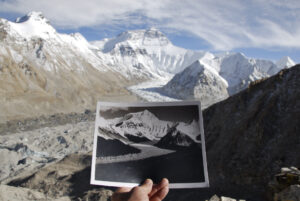
Photo by David Breashears
David Breashears (born 1955, Fort Benning, GA, USA)
Flying Over Mount Everest, 2012
Single-channel video
Duration: 1 minute, 27 seconds
Courtesy of GlacierWorks
Since 1983, mountaineer, photographer, and filmmaker David Breashears has summited Mount Everest five times, while creating documentaries that capture the majesty of the world’s tallest mountain. In 2007, Breashears was asked by PBS Frontline to document glacier melt in the Himalayas. He decided to recreate an iconic photograph that mountaineer George Mallory shot in 1921. Once he climbed to Mallory’s photo point, Breashears recalls: “There in front of me, I was holding Mallory’s photo. I could immediately see the results. If that glacier hadn’t shown such an extreme and accelerating melt rate, the project for me probably would have ended there.” Instead, Breashears founded GlacierWorks, a nonprofit organization that uses art, science, and adventure to raise public awareness about the consequences of climate change and has completed numerous expeditions to create comparative photographs, documenting glacier loss in the Greater Himalayan Region.
In Flying Over Mount Everest, Breashears captured panoramic views of a changing region by attaching six cameras to a helicopter that simultaneously shot photographs every three seconds. Website
Hear From The Photographer
Leo Cafe

Finding George Mallory’s Vantage Point. Photo by David Breashears
David Breashears (born 1955, Fort Benning, GA, USA)
Mount Everest, Khumbu Glacier, Nepal, 2007
Photograph printed on canvas
Courtesy of GlacierWorks
Mount Everest, Main Rongbuk Glacier, Tibet, China, 2007
Photograph printed on canvas
Courtesy of GlacierWorks
Since 1983, mountaineer, photographer, and filmmaker David Breashears has summited Mount Everest five times, while creating documentaries that capture the majesty of the world’s tallest mountain. In 2007, Breashears was asked by PBS Frontline to document glacier melt in the Himalayas. He decided to recreate an iconic photograph that mountaineer George Mallory shot in 1921. Once he climbed to Mallory’s photo point, Breashears recalls: “There in front of me, I was holding Mallory’s photo. I could immediately see the results. If that glacier hadn’t shown such an extreme and accelerating melt rate, the project for me probably would have ended there.” Instead, Breashears founded GlacierWorks, a nonprofit organization that uses art, science, and adventure to raise public awareness about the consequences of climate change and has completed numerous expeditions to create comparative photographs, documenting glacier loss in the Greater Himalayan Region.
In Flying Over Mount Everest, Breashears captured panoramic views of a changing region by attaching six cameras to a helicopter that simultaneously shot photographs every three seconds. Website
Hear From The Photographer
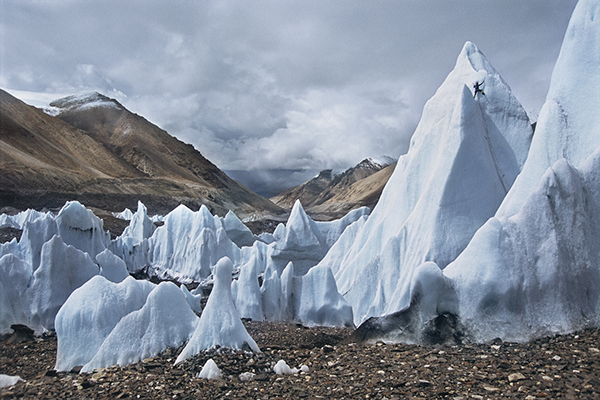
Jimmy Chin (born 1973, Mankato, MN, USA)
Mount Everest, Main Rongbuk Glacier, Tibet, China, 2007
Photograph printed on canvas
Courtesy of GlacierWorks
Jimmy Chin is an Asian American photographer, filmmaker, and mountain sports athlete known for his ability to capture extraordinary imagery while climbing and skiing in high-risk environments. With his wife Elizabeth Chai Vasarhelyi, he directed the films Meru (2015), which won the coveted Audience Award at the Sundance Film Festival, and Free Solo (2018), which won the Academy Award for Best Documentary Feature. Jimmy and Chai’s latest documentary, The Rescue (2021), chronicles the daring rescue of 12 boys and their coach from a cave in Thailand. The Rescue has won numerous awards including the People’s Choice Award at Toronto International Film Festival and was also shortlisted for an Academy Award. Chin and Vasarhelyi recently released their first scripted feature, Nyad, starring Annette Bening and Jodie Foster about Diana Nyad’s historic swim from Cuba to Florida.
As a mountaineer, he has both summited and skied down from Everest. Chin has garnered numerous photography awards from PDN, Communication Arts, the American Society of Magazine Editors, and others. Chin’s photos have appeared on the cover of National Geographic and The New York Times Magazine, among others. His most recent film is The Rescue (2020), which chronicles the 2018 rescue of a youth football team from Tham Luang cave in Thailand.
Website | Instagram | X
2nd Floor Landing
 Camille Seaman (born 1969, Huntington, NY, USA)
Camille Seaman (born 1969, Huntington, NY, USA)
Photographic prints mounted on aluminum
Courtesy of the artist
Giant NonTabular Iceberg, Weddell Sea, Antarctica, 2004
Giant Tabular Iceberg, Weddell Sea, Antarctica, 2004
Iceberg in Blood Red Sea, Lemaire Channel, Antarctica, 2016
Camille Seaman was born in 1969 to a Native American (Shinnecock tribe) father and African American mother. She graduated in 1992 from the State University of New York at Purchase, where she studied photography with Jan Groover and John Cohen. Seaman strongly believes in capturing photographs that articulate that humans are not separate from nature. Her photographs have been published in National Geographic, Italian Geo, German GEO, Time, The New York Times Sunday magazine, Newsweek, Outside, Zeit Wissen, Men’s Journal, Seed, Camera Arts, Issues, PDN, and American Photo, among many others. Her photographs have received many prizes including a National Geographic Award and the Critical Mass Top Monograph Award. She has been a TED Senior Fellow, Stanford Knight Fellow, and a Cinereach Fellow.
Website | Instagram | X | Facebook
Hear From The Photographer

Gideon Mendel (born 1959, Johannesburg, South Africa)
From the Submerged Portraits series
Photographic prints mounted on aluminum
Courtesy of the artist
João Pereira de Araújo, Taquari district, Rio Branco, Brazil, 2015 (left)
Terrence Mckeen with his mother, Gloria, Black Creek, Middleburg, Florida, USA, 2017
J.B. Singh, Jawahar Nagar, Srinagar, Kashmir, India, 2014
Muhammad Chuttal Korai, Pakistan, 2022
Gideon Mendel is a London-based photographer born in Johannesburg in 1959. He began photographing in the 1980s during the final years of apartheid. His first book, A Broken Landscape: HIV & AIDS in Africa, was published in 2001. Since then he has produced a number of photographic advocacy projects, working with charities and campaigning organizations. His work has been published in many leading magazines including National Geographic, Fortune Magazine, The Guardian Weekend Magazine, The Condé Nast Traveler, and Rolling Stone.
In 2007, after photographing two floods in the UK and India, Gideon Mendel, “was struck by the contrasting impacts of these floods, and the shared vulnerability that seems to unite the people.” Since then, he has traveled to flood zones around the world to witness this global catastrophe through photography and video. In Mendel’s Submerged Portraits series, his subjects, “pause and engage the camera, looking out from their inundated homes and devastated environments.” Mendel writes, “The pose may seem conventional yet the context is catastrophe, and their gazes are unsettling. They are not disempowered victims: they show agency amidst the calamity that has befallen them.”
Website | Instagram | X
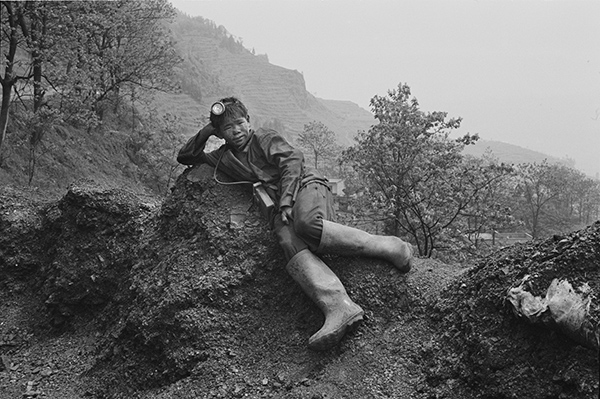
Geng Yunsheng (born 1954, Kunming, Yunnan Province, China)
From the Wumeng Miners series
Yunnan Province, China, 1995-2007
Photographic prints mounted on aluminum
Courtesy of the artist
In 1990, Geng Yunsheng took up photography and began documenting the everyday lives of coal miners in the Wumeng Mountains of Yunnan Province. Geng’s photographs reveal the living and working conditions of migrant workers in small, often illegal, coal mines in rural China. His images have brought attention to the perils of modern-day mining. Geng says that many city dwellers are “shocked” by his photographs; they cannot believe such conditions still exist in China.
While Geng records the harsh and dangerous conditions of coal mining, he acknowledges having conflicting feelings about the industry: “Some small-sized coal mines built by the locals provided for their cooking and heating needs. When the mines got closed, they had no other way to access coal except buying it, which they could barely afford due to their low income. . . . If mining is banned, the locals may turn to cutting down trees, another scarce resource. And this may do greater harm to the environment.” Many of these small mines have since been closed by the government, but coal remains a major energy source.
The project that resulted, Wumeng Miners has won him several national photographic awards, and has been widely exhibited in Germany, France and the U.S. A book with the same title was published in 2010.
Learn more about the Chinese photographers of COAL + ICE: two essays by Marina Svensson

Matt Black (born 1970, Santa Maria, CA, USA)
California, USA, 2009-2014
Photographic prints mounted on aluminum
Courtesy of Magnum Photos
Believing that “we’re all inevitably shaped by the environments we grow up in,” Matt Black has been photographing the Central Valley of California since 1995. His work explores the connections between migration, poverty, agriculture, and the environment in the region.
Over the last century, the Central Valley was transformed from a semi-arid region into one of the world’s largest food producers by the importation of water. Today, drought, compounded by decades of insufficient water management and excessive farming, is causing the land to dry up and revert to its semi-arid state. Black’s black-and-white photographs show parched landscapes and shriveled crops—a contrast to the brightly colored fruits and vegetables we encounter in grocery stores.
Beside these damaged lands, Black portrays people working in the fields whose lives are affected most immediately by the changes to the land, from job loss to contaminated tap water and fertilizer exposure.
Black photographed over one hundred communities across 44 U.S. states for his project, The Geography of Poverty. He is an Associate Member of Magnum Photos. He received the W. Eugene Smith Award in 2015 and the Robert F. Kennedy Journalism Award in 2016. His work has also been honored by the Magnum Foundation Emergency Fund, the Pulitzer Center on Crisis Reporting, the Center for Cultural Innovation, and others.
Website | Instagram | Twitter | Facebook
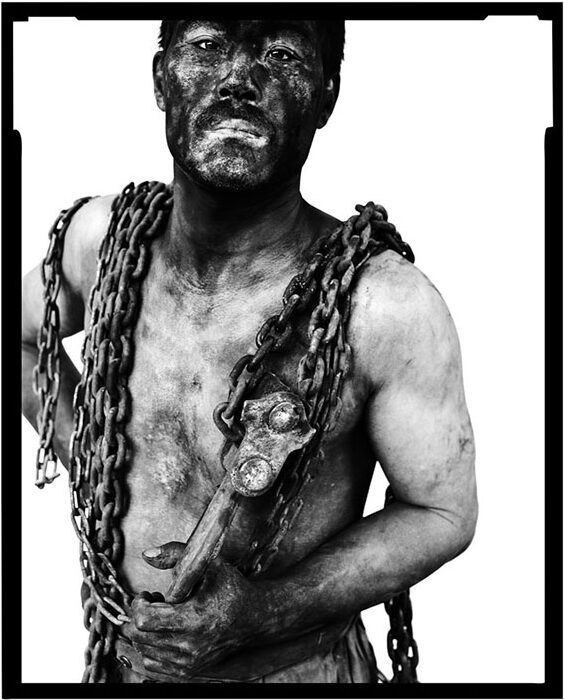
Song Chao (born 1979, Dongming County, Shandong Province, China)
From the Miners series
Shandong Province, China, 2002
Photographic prints mounted on aluminum
Courtesy of the artist
The familiarity conveyed by Song Chao’s portraits comes from his own experience working in the coal mines of Shandong province. Song says he began photographing his miner friends and colleagues to show that, “the Chinese miner is not a cold, coal-mining machine—there are rich and delicate emotions and unique characters beneath each rough appearance.”
Song’s work also illustrates the complex relationship society has with fossil fuels. “As China has developed rapidly over the past several decades, it has done so on the back of the coal industry and the workers who spend their days, and risk their lives, toiling in the mines. But, as we all know, coal is a nonrenewable resource, and people across China have grown worried about the potential ecological impact of our reliance on it,” the artist says.
His projects since then have included Miners I and II, Miner’s Families, Coal Mine Community, and two projects on migration, Migrant Workers and Hold. All feature his signature style of stark black-and-white portraiture with a whited-out background. In 2002, Song received the Chinese National Photography Award.
Learn more about the Chinese photographers of COAL + ICE: two essays by Marina Svensson
Ross Gallery
 Gideon Mendel (born 1959, Johannesburg, South Africa)
Gideon Mendel (born 1959, Johannesburg, South Africa)Deluge
Filmed in Pakistan (2010), Thailand (2011), Nigeria (2012), Germany (2013), UK (2014 and 2015), Kashmir, India (2014), Brazil (2015), Bangladesh (2015), USA (2015 and 2017), and France (2016 and 2018)
Four-channel video
Duration: 13 minutes, 27 seconds
Courtesy of the artist
Gideon Mendel is a London-based photographer born in Johannesburg in 1959. He began photographing in the 1980s during the final years of apartheid. His first book, A Broken Landscape: HIV & AIDS in Africa, was published in 2001. Since then he has produced a number of photographic advocacy projects, working with charities and campaigning organizations. His work has been published in many leading magazines including National Geographic, Fortune Magazine, The Guardian Weekend Magazine, The Condé Nast Traveler, and Rolling Stone.
In 2007, after photographing two floods in the UK and India, Gideon Mendel, “was struck by the contrasting impacts of these floods, and the shared vulnerability that seems to unite the people.” Since then, he has traveled to flood zones around the world to witness this global catastrophe through photography and video. Deluge opens with landscapes devoid of humans and slowly begins to reveal the catastrophic consequences as people enter the frame rowing and trudging through rising tides of endless sludge. Through these intimate portrayals of individuals and families across ten countries, Mendel shows the shared global experiences of climate disaster.
Website | Instagram | X
Starr Gallery
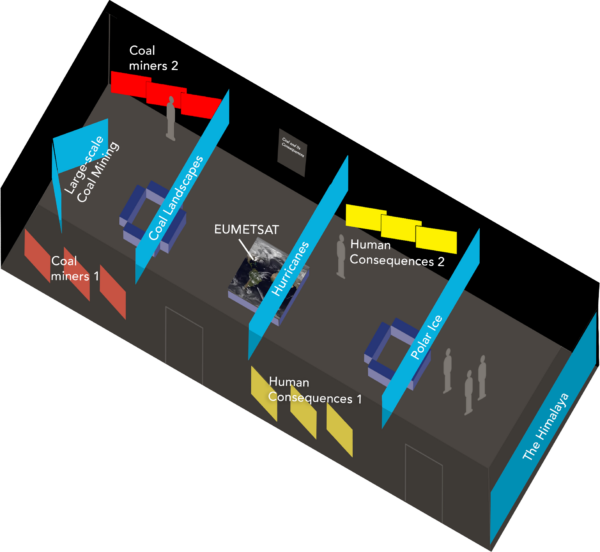
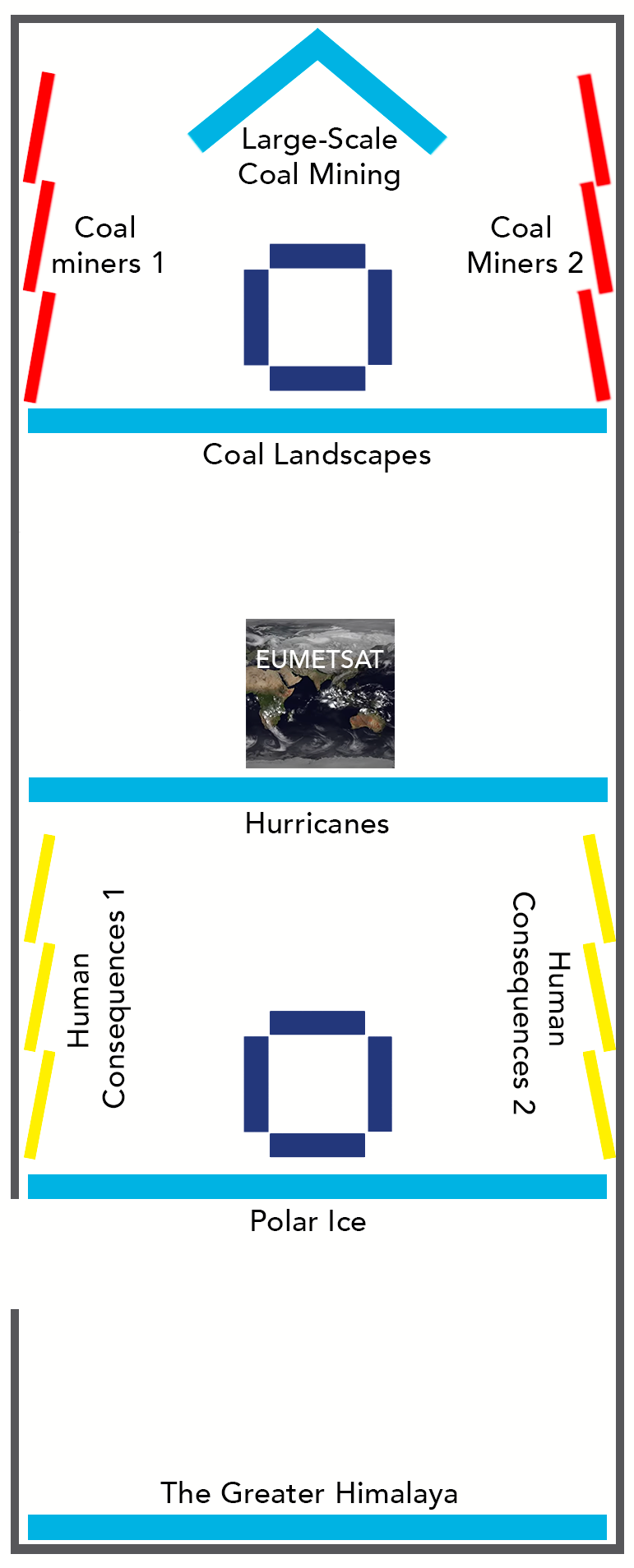
Coal Miners 1
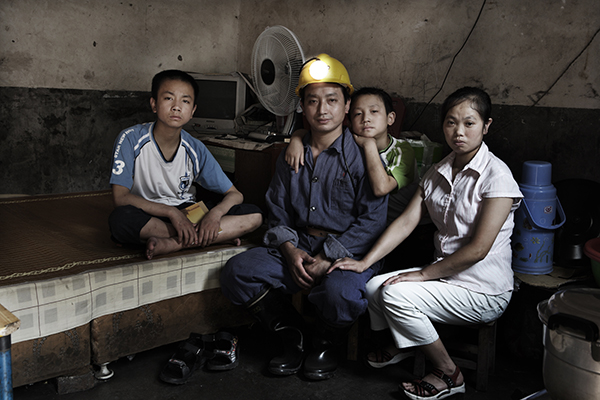 Yu Haibo (born 1962, Henan Province, China)
Yu Haibo (born 1962, Henan Province, China)
Henan province, China, 2007
Photographs projected on three screens
Courtesy of the artist
Born in Yongcheng, Henan province in 1962. Yu Haibo graduated from Wuhan University as a photography major. Yu has won many national and provincial photographic awards. Since 2006, his project Dafen Oil Painting Village has been widely exhibited in China, Amsterdam, Paris, Zurich and Lodz, Poland, and collected by the San Francisco Museum of Modern Art. He is now the chief news photographer of the Shenzhen Economic Daily. He is also the Director of the Shenzhen Professional Photography Association.
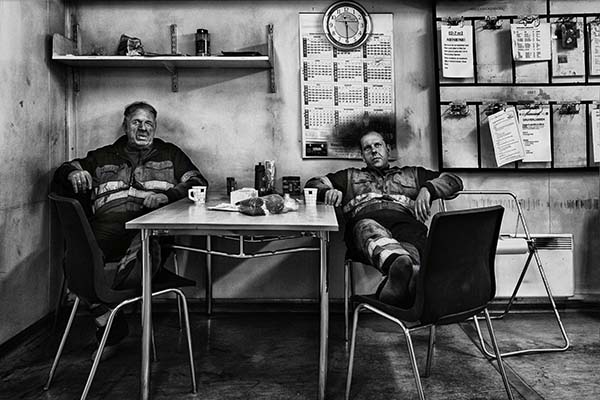 Anna Filipova
Anna Filipova
Svalbard, Norway, 2016
Photographs projected on three screens
Courtesy of the artist
Anna Filipova is a photojournalist and a researcher based in Paris. She has been working for The New York Times International Edition, The International Herald Tribune, and Reuters News Agency and has been published in CNN, Washington Post, The Telegraph, Dazed & Confused, and The Guardian, amongst others. For the past few years, she has been focusing on the Arctic region, where she explores environmental and social topics in remote and inaccessible areas. She has a MA from the Royal College of Art in London. Most recently, the mayor of Paris and President of C40 Cities Climate Leadership Group selected Filipova as one of the climate heroines representing the city of Paris.
I live in the Arctic, where I cover environmental and science stories. I always try to reveal unseen stories, and to create a sense of wonder. I hope my work will help to strengthen the presence of women in science and environmental photojournalism where previously the feminine perspective has been underrepresented.
Niu Guozheng (born 1955, Henan Province, China)
Henan Province, China, 2007
Photographs projected on three screens
Courtesy of the artist
Born in 1955 in Henan province’s Baofeng county, Niu has been a freelance photographer since the 1980s and began to photograph coal mines in 1987. He chose coal as his subject because of its centrality in daily life in his home city of Pingdingshan. He has also worked as an official in the Pingdingshan City Bureau of Public Security since 1980, due to the difficulty of making a living as a full-time photographer in China. His major works include Career Behind Bars, Martial Arts, In Dreams, Garden of Hundred Flowers, Small Coal Mines, and Exercises. Niu’s work is in the collection of the San Francisco Museum of Modern Art and has been published in Germany, the United Kingdom, Italy, Hong Kong, and Taiwan.
Learn more about the Chinese photographers of COAL + ICE: two essays by Marina Svensson
Geng Yunsheng (born 1954, Kunming, Yunnan Province, China)
From the Wumeng Miners series
Yunnan Province, China, 1995-2007
Photographs projected on three screens
Courtesy of the artist
In 1990, Geng Yunsheng took up photography and began documenting the everyday lives of coal miners in the Wumeng Mountains of Yunnan Province. Geng’s photographs reveal the living and working conditions of migrant workers in small, often illegal, coal mines in rural China. His images have brought attention to the perils of modern-day mining. Geng says that many city dwellers are “shocked” by his photographs; they cannot believe such conditions still exist in China.
While Geng records the harsh and dangerous conditions of coal mining, he acknowledges having conflicting feelings about the industry: “Some small-sized coal mines built by the locals provided for their cooking and heating needs. When the mines got closed, they had no other way to access coal except buying it, which they could barely afford due to their low income. . . . If mining is banned, the locals may turn to cutting down trees, another scarce resource. And this may do greater harm to the environment.” Many of these small mines have since been closed by the government, but coal remains a major energy source.
The project that resulted, Wumeng Miners has won him several national photographic awards, and has been widely exhibited in Germany, France and the U.S. A book with the same title was published in 2010.
Learn more about the Chinese photographers of COAL + ICE: two essays by Marina Svensson
Coal Miners 2
“Photography is an empathy towards the world.”
–Lewis Hine
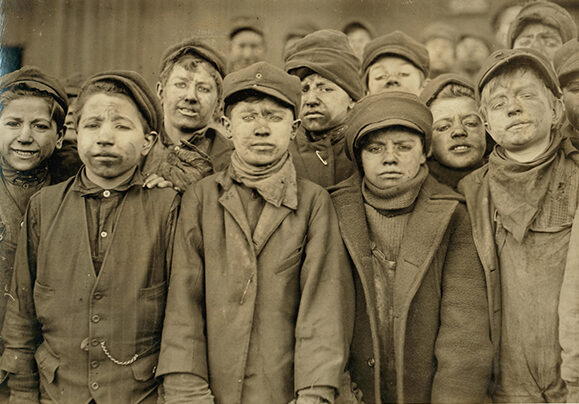
Lewis Hine (born 1874, Oshkosh, Wisconsin, USA)
West Virginia, Alabama, and Pennsylvania, USA, 1908-1911
Photographs projected on three screens
Courtesy of the Library of Congress
Lewis Hine was an American teacher, sociologist, and muckraking photographer whose photographs helped expose and end child labor in the United States. Born in Oshkosh, Wisconsin, Hine took up photography in 1904 to document immigrants arriving at Ellis Island. After attending the Columbia University School of Social Work, Hine began photographing for the National Child Labor Committee (NCLC) in 1907. He traveled from Maine to Texas documenting children working in factories, mines, mills, farms, and street trades. Declaring that he “wanted to show things that had to be corrected,” Hine was one of the earliest photographers to use the photograph as a documentary tool. In 1936 Hine was appointed head photographer for the National Research Project of the Works Projects Administration. He died in 1940.
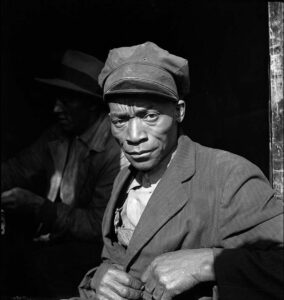 Gordon Parks (born 1912, Fort Scott Kansas)
Gordon Parks (born 1912, Fort Scott Kansas)
New York and Washington, D.C., USA, 1942-1946
Courtesy of the Gordon Parks Foundation
Gordon Parks was a dedicated humanitarian who broke the color line to become one of the most celebrated American photographers of the 20th century. Born in Kansas in 1912, Parks experienced first-hand deep American racism and poverty. He taught himself photography as a tool for documenting the social conditions he saw around him. Despite his lack of training, Parks became a photographer for New Deal-era government agencies and traveled the country documenting race relations and social inequality. He would continue to photograph American society, protest movements, fashion, and urban life in a long career as a Life magazine staffer and freelance photojournalist. A renaissance man, Parks was also a pioneering blaxploitation filmmaker, writer, painter, and composer.
–Gordon Parks, A Choice of Weapons, 1967
–Joris Ivens, Los Angeles Times interview, 1988
 Joris Ivens (born 1898, Netherlands)
Joris Ivens (born 1898, Netherlands)
Selections from Misère au Borinage
Borinage, Belgium, 1934
Video projected on three screens
Courtesy of Tamasa Distribution and the Henri Storck Foundation
Joris Ivens, born Georg Henri Anton Ivens in 1898 in the Netherlands, was a Dutch filmmaker who explored leftist social and political concerns. Ivens received acclaim for two of his early films, The Bridge (1928) and Rain (1929). His successes resulted in an invitation to lecture in the Soviet Union, where he made Song of Heroes (1932). His most famous film was The Spanish Earth (1937), an anti-Franco report on the Spanish Civil War written by Ernest Hemingway and Jon Dos Passos and narrated by Orson Welles. His film The Power and the Land (1940) documents the New Deal’s rural electrification program. He died in Paris in 1989.
“The camera that lacks respect for human beings distorts the truth.”
–Henri Storck, interview by Andrée Tournès, 1988
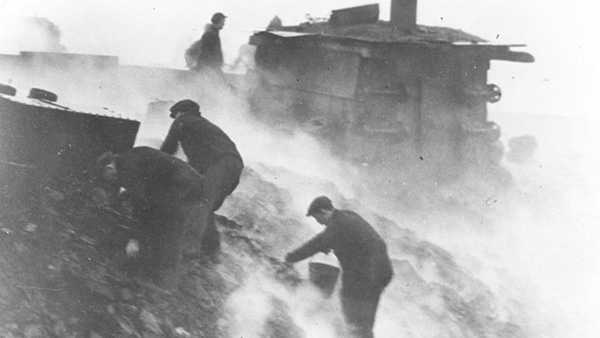
Henri Storck (born 1907, Ostend, Belgium)
Selections from Misère au Borinage
Borinage, Belgium, 1934
Video projected on three screens
Courtesy of the Henri Storck Foundation and Tamasa Distribution.
Henri Storck was a filmmaker and an important member of the Belgian avant-garde in the 1920s and ‘30s. As a young man, he was influenced by surrealism and was associated with René Magritte, André Malraux, Louis Aragon, and others. His early films were silent “ethnographic” tableaus depicting everyday life in his home region. Storck was best known for his social documentaries, most notably Misery in Borinage, which he made together with Joris Ivens. During World War II he filmed the sociological documentary Farmers’ Symphony. Storck made nearly 100 films. He died in 1999.
Bruce Davidson (born 1933, Oak Park, Illinois)
Wales, United Kingdom
Photographs projected on three screens
Courtesy of Magnum Photos
Bruce Davidson began taking photographs at the age of ten in Oak Park, Illinois. He became a full member of Magnum Photos in 1958 and created such seminal bodies of work as The Dwarf, Brooklyn Gang, and Freedom Rides. In 1963 the Museum of Modern Art in New York presented his early work in a solo show. His work witnessing the dire social conditions on one block in East Harlem was published in 1970 under the title East 100th Street. In 1980, he captured the vitality of the New York Metro’s underworld that was later published in a book, Subway. His awards include the Lucie Award for Outstanding Achievement in Documentary Photography in 2004 and a Gold Medal Lifetime Achievement Award from the National Arts Club in 2007.

Song Chao (born 1979, Dongming County, Shandong Province, China)
Photographs projected on three screens
From the Miners series
Shandong Province, China, 2002
Courtesy of the artist
The familiarity conveyed by Song Chao’s portraits comes from his own experience working in the coal mines of Shandong province. Song says he began photographing his miner friends and colleagues to show that, “the Chinese miner is not a cold, coal-mining machine—there are rich and delicate emotions and unique characters beneath each rough appearance.”
Song’s work also illustrates the complex relationship society has with fossil fuels. “As China has developed rapidly over the past several decades, it has done so on the back of the coal industry and the workers who spend their days, and risk their lives, toiling in the mines. But, as we all know, coal is a nonrenewable resource, and people across China have grown worried about the potential ecological impact of our reliance on it,” the artist says.
His projects since then have included Miners I and II, Miner’s Families, Coal Mine Community, and two projects on migration, Migrant Workers and Hold. All feature his signature style of stark black-and-white portraiture with a whited-out background. In 2002, Song received the Chinese National Photography Award.
Learn more about the Chinese photographers of COAL + ICE: two essays by Marina Svensson
Large-Scale Coal Mining

Photo by Wolf Hertzberg
This two-screen projection was created using found footage of large-scale contemporary coal mining operations by COAL + ICE co-curator Jeroen de Vries. It is rare for independent documentary photographers and filmmakers to have access to large coal mines, especially in China, where half of the material comes from. Most of the footage is a combination of marketing material created by coal companies and clips from Chinese state TV. De Vries’ unique mirrored format turns the commercial footage into an artistic presentation that renders earthly images, many of them literally taken underground, otherworldly and strange.
Jeroen de Vries is the designer and co-curator of COAL + ICE He lives in Amsterdam and Belgrade and works as a freelance designer, curator and teacher. Website
Coal Landscapes
“It is hardly surprising that I was overcome with horror when I noticed that the world in which I was besotted was disappearing.”
–Bernd Becher
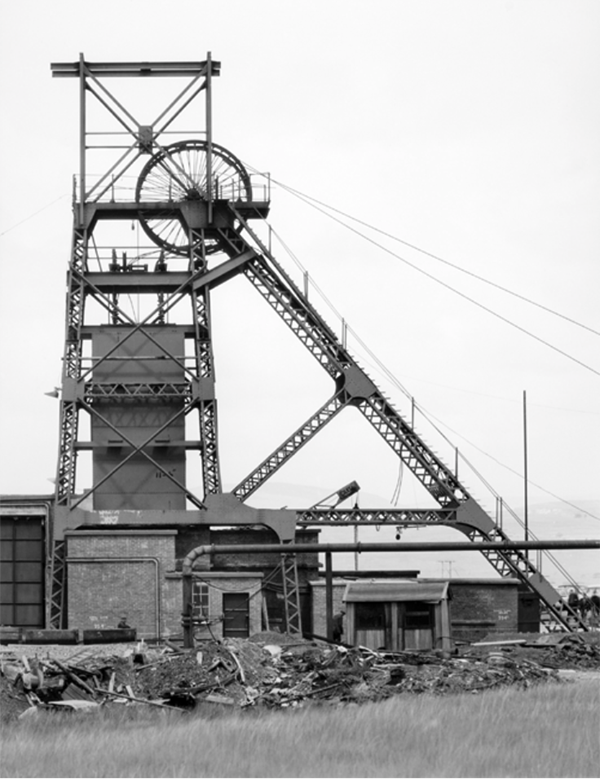 Bernd Becher (born 1931, Siegen, Germany)
Bernd Becher (born 1931, Siegen, Germany)
Hilla Becher (born 1934, Potsdam, Germany)
Germany, France and the UK, 1966-1967
Photographs projected on three screens
Courtesy of SK Stiftung Kultur
Bernd and Hilla Becher were German photographers whose systematic documentation of their country’s disappearing industrial landscape has been enormously influential for contemporary documentary photography. Inspired by the German interwar New Objectivity movement, the Bechers used rigorous, static composition to photograph their subjects with an almost scientific detachment. The serial photographic “typologies” they created were the signature of what came to be known as the Dusseldorf School, after the Kunstakademie Dusseldorf where the pair taught. Their work influenced a generation of German photographers including Andreas Gursky, Thomas Struth, and Candida Höfer. Bernd died in 2007 and Hilla in 2015, both in Germany.
 John Davies (born 1949, County Durham, UK)
John Davies (born 1949, County Durham, UK)
Great Britain, 1979-1980
Photographs projected on three screens
Courtesy of L. Parker Stephenson Photographs
John Davies studied photography in Nottingham, and after graduating in 1974 he became fascinated by the rural landscape during his visits to the west coast of Ireland. His images of Ireland, Scotland, and England, made between 1976 and 1981, were published in the monograph Mist Mountain Water Wind in 1985. In 1981 he won a Research Fellowship at Sheffield School of Art and in 1995-1996 he was a Senior Research Fellow at the Art School at the University of Wales. Davies was the first photographer to be commissioned by the Museum of London in 2001. His work has been shown at many international venues including the Museum of Modern Art in New York and the Pompidou Centre in Paris. Website
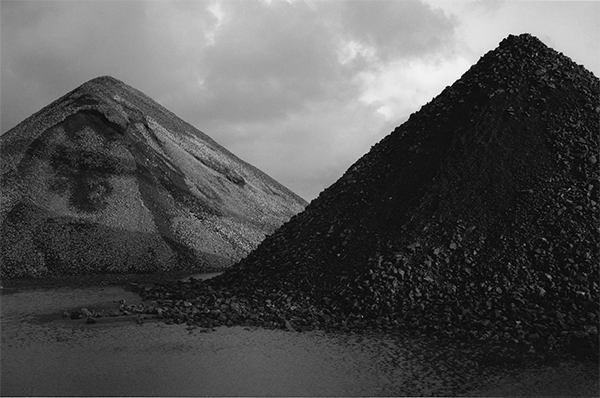 Willem Diepraam (born 1944, Amsterdam, The Netherlands)
Willem Diepraam (born 1944, Amsterdam, The Netherlands)
The Netherlands, 1993
Photographs projected on three screens
Courtesy of the artist
Willem Diepraam began his career in the 1960s as a self-taught photojournalist working for the Dutch newspaper Vrij Nederland. Diepraam’s work demonstrates a sincere concern for the plight of the world’s underprivileged, while his eye never sacrifices elegant form and composition. He has published several books of his own work, including Dutch Caribbean (1975), Sahel (1982), Lima (1991), and Foto’s and Photographs (2000). Diepraam donated part of a 400-print collection of original prints by some of the greatest names in the field to the Rijksmuseum. Website
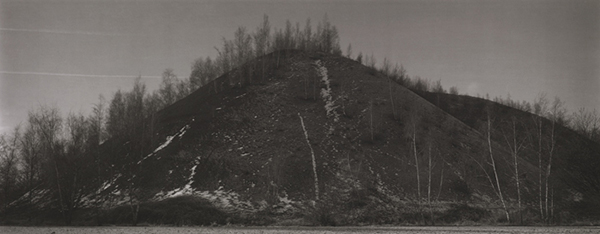 Witho Worms (born 1959, Amsterdam, The Netherlands)
Witho Worms (born 1959, Amsterdam, The Netherlands)
Belgium, France, Germany, Poland, and Wales, 2006-2011
Photographs projected on three screens
Courtesy of L. Parker Stephenson Photographs
Witho Worms is a Dutch artist-photographer. He has a Master’s degree in Anthropology from the Vrije Universiteit, Amsterdam and studied Audiovisual design and Photography at Utrecht School of the Arts. His background in visual anthropology has led him into an ongoing investigation of the photographic medium and its claim to natural representation and factuality. After photographing the Dutch polders he shifted his attention to slagheaps in the coal mining industries in Western Europe in 2006. In 2013 he started to work on forests in Finland, Sweden, France, and Belgium. His publication La montagne c’est moi was named “The Best Dutch Book Design, 2012” and was short-listed for the Paris Photo-Aperture first Photo Book Award. Stiftung Buchkunst in Germany awarded him the Gold Medal in 2013 for best book design. Website | Instagram
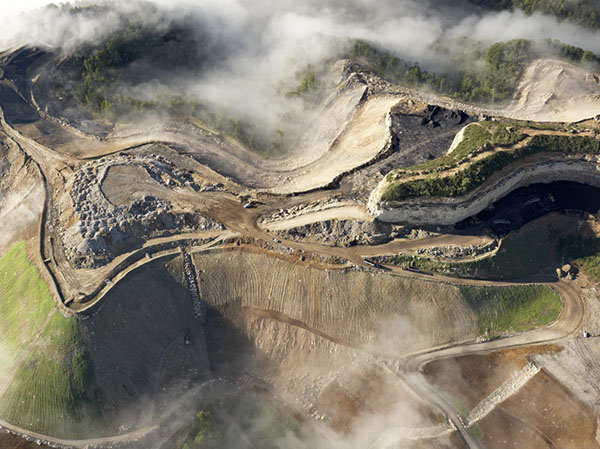 Cameron Davidson (born 1955, Miami, Florida)
Cameron Davidson (born 1955, Miami, Florida)
West Virginia, USA, 2005
Photographs projected on three screens
Courtesy of the artist
Aerial and location photographer Cameron Davidson calls Northern Virginia home. He creates images from the skies around the globe for advertising campaigns, annual reports, and editorial features. Clients include Vanity Fair, American Express’ Departures, National Geographic, Audubon, Smithsonian, Dominion, and Virginia Tourism. An avid volunteer and board member for the Community Coalition for Haiti (CCH), Davidson has documented CCH aid projects in central and southern Haiti since 1999. Website | Blog | Instagram
Hear From the Photographer
Showing the scars from the impact of mountaintop removal coal mining in contrast with the surrounding and untouched landscape was my intent. I felt that showing this desecration of the southern Appalachian Mountains from an aerial perspective would have the greatest impression upon viewers and help them understand the impact on the landscape and watersheds from this type of coal mining.
To be a part of the COAL + ICE exhibition is an honor. This traveling exhibit brings home the message of a focused approach to the consequences of long-term energy consumption and reliance on coal as a source of electrical power.
Anna Filipova
Svalbard, Norway, 2016
Photographs projected on three screens
Courtesy of the artist
Anna Filipova is a photojournalist and a researcher based in Paris. She has been working for The New York Times International Edition, The International Herald Tribune, and Reuters News Agency and has been published in CNN, Washington Post, The Telegraph, Dazed & Confused, and The Guardian, amongst others. For the past few years, she has been focusing on the Arctic region, where she explores environmental and social topics in remote and inaccessible areas. She has a MA from the Royal College of Art in London. Most recently, the mayor of Paris and President of C40 Cities Climate Leadership Group selected Filipova as one of the climate heroines representing the city of Paris. Website | Twitter | Instagram
Hear From the Photographer
I live in the Arctic, where I cover environmental and science stories. I always try to reveal unseen stories, and to create a sense of wonder. I hope my work will help to strengthen the presence of women in science and environmental photojournalism where previously the feminine perspective has been underrepresented.
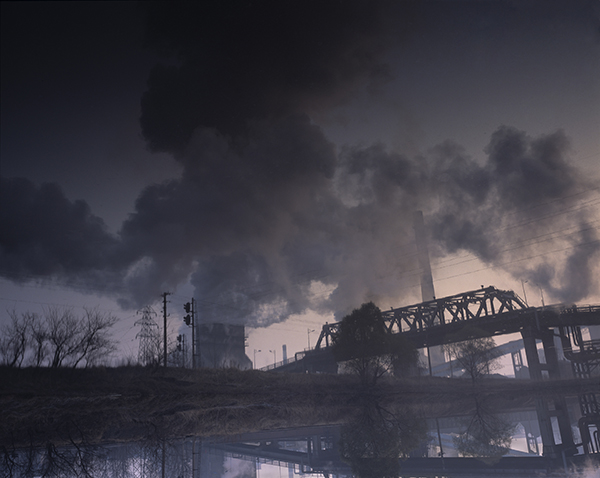
Niu Guozheng (born 1955, Henan Province, China)
Henan Province, China, 2006
Photographs projected on three screens
Courtesy of the artist
Born in 1955 in Henan province’s Baofeng county, Niu has been a freelance photographer since the 1980s and began to photograph coal mines in 1987. He chose coal as his subject because of its centrality in daily life in his home city of Pingdingshan. He has also worked as an official in the Pingdingshan City Bureau of Public Security since 1980, due to the difficulty of making a living as a full-time photographer in China. His major works include Career Behind Bars, Martial Arts, In Dreams, Garden of Hundred Flowers, Small Coal Mines, and Exercises. Niu’s work is in the collection of the San Francisco Museum of Modern Art and has been published in Germany, the United Kingdom, Italy, Hong Kong, and Taiwan.
Learn more about the Chinese photographers of COAL + ICE: two essays by Marina Svensson
 Peter van Agtmael (born 1981, Washington, D.C., USA)
Peter van Agtmael (born 1981, Washington, D.C., USA)
Southern Illinois, USA, 2017
Photographs projected on three screens
Courtesy of Magnum Photos
Peter van Agtmael was born in Washington, D.C. in 1981. His work concentrates on America, looking at issues of conflict, identity, power, race, and class. He won the W. Eugene Smith Grant, the ICP Infinity Award for Young Photographer, the Lumix Freelens Award, the Aaron Siskind Grant, and a Magnum Foundation Grant, as well as awards from World Press Photo, American Photography Annual, POYi, The Pulitzer Center, The Center for Documentary Studies at Duke University, FOAM, and Photo District News. His book Disco Night Sept 11, on America at war in the post-9/11 era, was named a “Book of the Year” by The New York Times Magazine, Time magazine, Mother Jones, Vogue, American Photo, and Photo Eye. His project Power Down is a portrait of the social and symbolic life of coal in contemporary America. Agtmael joined Magnum Photos in 2008 and became a member in 2013.
Website | Instagram | X
Daniel Beltrá (born 1964, Madrid, Spain)
Indonesia, 2009
Photographs projected on three screens
Courtesy of the artist
Born in Madrid, Spain, Daniel Beltrá is a photographer based in Seattle, Washington. His passion for conservation is evident in images of our environment that are evocatively poignant. In 2011 he received the Wildlife Photographer of the Year Award and the Lucie Award for the International Photographer of the Year – Deeper Perspective for his photography of the Deepwater Horizon Gulf Oil Spill. In 2009 he received the prestigious Prince’s Rainforest Project award granted by Prince Charles. He won the BBVA Foundation award in 2013. Beltrá’s work has been published in many international publications including The New Yorker, Time, Newsweek, The New York Times, Le Monde, and El Pais. He is a fellow of the prestigious International League of Conservation Photographers.
Website | Instagram
Hear From the Photographer
Polar Ice
 Daniel Beltrá (born 1964, Madrid, Spain)
Daniel Beltrá (born 1964, Madrid, Spain)
Indonesia, 2009
Photographs projected on three screens
Courtesy of the artist
Born in Madrid, Spain, Daniel Beltrá is a photographer based in Seattle, Washington. His passion for conservation is evident in images of our environment that are evocatively poignant. In 2011 he received the Wildlife Photographer of the Year Award and the Lucie Award for the International Photographer of the Year – Deeper Perspective for his photography of the Deepwater Horizon Gulf Oil Spill. In 2009 he received the prestigious Prince’s Rainforest Project award granted by Prince Charles. He won the BBVA Foundation award in 2013. Beltrá’s work has been published in many international publications including The New Yorker, Time, Newsweek, The New York Times, Le Monde, and El Pais. He is a fellow of the prestigious International League of Conservation Photographers.
Website | Instagram
Hear From The Photographer
 Camille Seaman (born 1969, Huntington, NY, USA)
Camille Seaman (born 1969, Huntington, NY, USA)
Antarctica; East and South Greenland; Svalbard, Norway, 2004-2017
Photographs projected on three screens
Courtesy of the artist
Camille Seaman was born in 1969 to a Native American (Shinnecock tribe) father and African American mother. She graduated in 1992 from the State University of New York at Purchase, where she studied photography with Jan Groover and John Cohen. Seaman strongly believes in capturing photographs that articulate that humans are not separate from nature. Her photographs have been published in National Geographic, Italian Geo, German GEO, Time, The New York Times Sunday magazine, Newsweek, Outside, Zeit Wissen, Men’s Journal, Seed, Camera Arts, Issues, PDN, and American Photo, among many others. Her photographs have received many prizes including a National Geographic Award and the Critical Mass Top Monograph Award. She has been a TED Senior Fellow, Stanford Knight Fellow, and a Cinereach Fellow.
Website | Instagram | X | Facebook
Hear From The Photographer
Hurricanes
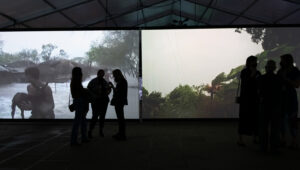
Photo by Margot Schulman
This three-screen projection created by COAL + ICE curator Jeroen de Vries uses found footage of hurricanes from the United States, India, Bangladesh, the Philippines, Mexico, and Cape Verde, along with several Caribbean and Central American countries. Most of the footage comes from social media, captured by people who found themselves in the middle of the storms and used their smartphones to document what was happening around them. Additional footage is taken from local news and other sources.
Jeroen de Vries is the designer and co-curator of Coal + Ice. He lives in Amsterdam and Belgrade and works as a freelance designer, curator and teacher. Website
The European Organization for the Exploitation of Meteorological Satellites, or EUMETSAT, is a pan-European entity that operates meteorological satellites that monitor weather patterns and climate conditions. “A Year of Weather 2017” is one of a series of videos produced by EUMETSAT that compile images from several different satellite systems to depict an entire year of earth’s weather. The information gathered by EUMESTAT and similar organizations in the United States, Japan, and elsewhere is crucial to our ongoing understanding of long-term effects of global warming. Website | Twitter | Facebook | Youtube
Himalayas
 David Breashears is an accomplished mountaineer, photographer, and filmmaker. He is also the founder and Executive Director of GlacierWorks, a non-profit organization that uses art, science, and adventure to raise public awareness about the consequences of climate change in the Greater Himalayan Region. Since 1978 he has combined his skills in climbing and filmmaking to complete more than forty film projects. He co-directed and produced the first IMAX film shot on Mount Everest, and reached the summit of Everest for the fifth time in 2004 when shooting his film Storm Over Everest. Website
David Breashears is an accomplished mountaineer, photographer, and filmmaker. He is also the founder and Executive Director of GlacierWorks, a non-profit organization that uses art, science, and adventure to raise public awareness about the consequences of climate change in the Greater Himalayan Region. Since 1978 he has combined his skills in climbing and filmmaking to complete more than forty film projects. He co-directed and produced the first IMAX film shot on Mount Everest, and reached the summit of Everest for the fifth time in 2004 when shooting his film Storm Over Everest. Website
Hear From The Photographer
“It was a prodigious white fang excrescent from the jaw of the world. We saw Mount Everest not quite sharply defined on account of a slight haze in that direction; this circumstance added a touch of mystery and grandeur; we were satisfied that the highest of the mountains would not disappoint us.”
–George Mallory, diary entry, 1921
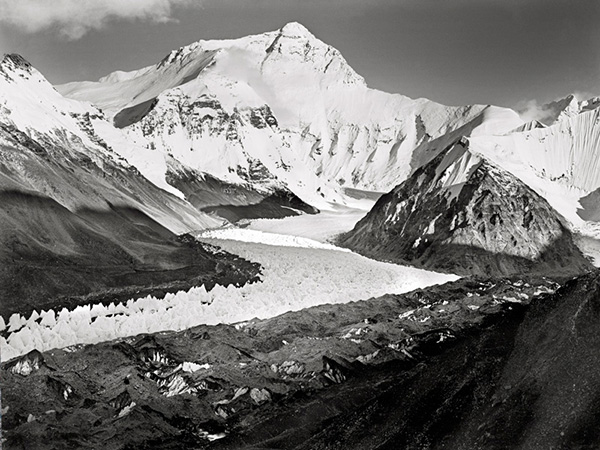 Born in 1886, George Mallory was an English mountaineer who took part in the first three British expeditions to Mount Everest in the early 1920s. A graduate of Cambridge and a veteran of World War I, Mallory has come to exemplify the dauntless, driven spirit of the first generation of European Everest pioneers. When asked why he wanted to climb Everest, he famously answered “because it’s there.” Mallory and his partner Andrew “Sandy” Irvine disappeared high on Everest during their 1924 Expedition, their second attempt to reach the summit. While Mallory’s body was discovered several hundred feet below the peak in 1999, speculation that he and Irvine could have been the first people to reach the top has never been resolved.
Born in 1886, George Mallory was an English mountaineer who took part in the first three British expeditions to Mount Everest in the early 1920s. A graduate of Cambridge and a veteran of World War I, Mallory has come to exemplify the dauntless, driven spirit of the first generation of European Everest pioneers. When asked why he wanted to climb Everest, he famously answered “because it’s there.” Mallory and his partner Andrew “Sandy” Irvine disappeared high on Everest during their 1924 Expedition, their second attempt to reach the summit. While Mallory’s body was discovered several hundred feet below the peak in 1999, speculation that he and Irvine could have been the first people to reach the top has never been resolved.
“I am very frequently asked: ‘What is to be gained when you do reach the summit of Mount Everest?’ From a commercial point of view, nothing….But surely it will be a very great achievement to reach the highest known point on the earth’s surface, and one which should be most appreciated.”
–E. O. Wheeler, 1923
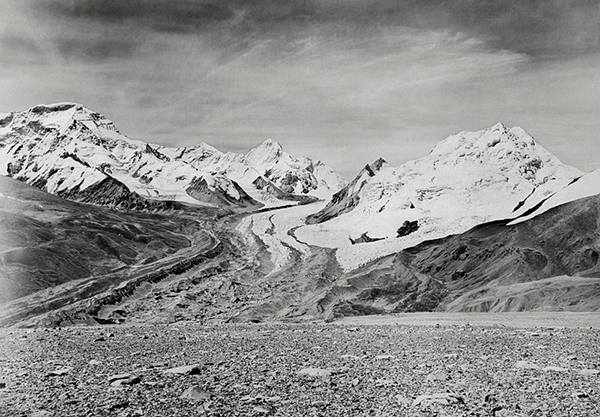 Born in 1890, Edward Oliver Wheeler was a Canadian mountaineer who participated in the first British expedition to Mount Everest, in 1921. A battle-hardened veteran of the First World War, he served as the expedition’s surveyor, introducing the technique of photogrammetric mapping to the British mountaineering elite. While the more famous George Mallory has come to embody the heroic spirit of the early Himalayan pioneers, it was Wheeler who identified the route up Everest with his photographic surveys, thus making it possible for the mountain to finally be summited a generation later.
Born in 1890, Edward Oliver Wheeler was a Canadian mountaineer who participated in the first British expedition to Mount Everest, in 1921. A battle-hardened veteran of the First World War, he served as the expedition’s surveyor, introducing the technique of photogrammetric mapping to the British mountaineering elite. While the more famous George Mallory has come to embody the heroic spirit of the early Himalayan pioneers, it was Wheeler who identified the route up Everest with his photographic surveys, thus making it possible for the mountain to finally be summited a generation later.
“The wish to reproduce faithfully the atmosphere of the panorama even more accurately than it can be seen by the eye or retained by the mind delights the photographer.”
–Vittorio Sella
“The purity of Sella’s interpretations move the spectator to a religious awe.”
–Ansel Adams, Sierra Club Bulletin, 1946
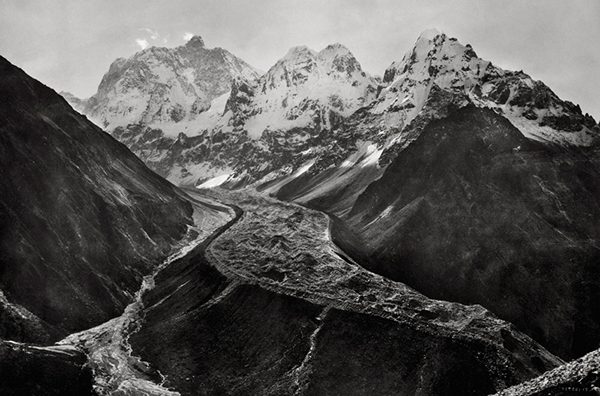 Vittorio Sella was born in the foothills of the Alps in Biella, Italy in 1859. During his long and industrious career as a photographer and mountaineer, Sella took part in many expeditions to the world’s greatest and least explored mountain ranges. Using large-format cameras that had to be carried up the mountain and often developing his plates in portable dark rooms, Sella’s photographs captured alpine scenes with unprecedented vividness and detail.
Vittorio Sella was born in the foothills of the Alps in Biella, Italy in 1859. During his long and industrious career as a photographer and mountaineer, Sella took part in many expeditions to the world’s greatest and least explored mountain ranges. Using large-format cameras that had to be carried up the mountain and often developing his plates in portable dark rooms, Sella’s photographs captured alpine scenes with unprecedented vividness and detail.
Human Consequences 1
Dana Lixenberg (born 1964, Amsterdam, The Netherlands)
From the series, The Last Days of Shishmaref, Alaska, USA, 2007
Photographs projected on three screens
Courtesy of GRIMM Gallery
Dana Lixenberg was born in Amsterdam and studied at the London College of Printing and the Gerrit Rietveld Academie. She is known for her understated, intimate portraits, often of underserved communities. Her work is characterized by compositional rigor and the absence of social stereotyping. She uses a large-format camera, which necessitates what she calls a “slow dance” between her and her subjects. Lixenberg’s most extensive project to date is Imperial Courts, 1993-2015, which began in the aftermath of the 1992 Rodney King riots and which documents life in a federal housing project in Watts, Los Angeles over 22 years. Other large-scale projects include Jeffersonville, Indiana (2005), a collection of landscapes and portraits of a small town’s homeless population, and The Last Days of Shishmaref (2008), from which a selection is presented in COAL + ICE. In her editorial work, Lixenberg has also photographed many cultural icons in the United States including Tupac Shakur, Toni Morrison, and Noam Chomsky. Website | Instagram
Hear From The Photographer
In my projects, I often focus on small, socially and economically isolated communities where I can build relationships with the people and learn about the issues that affect their lives. By spending a certain amount of time in a community, I am exposed to the intimate and often complex relations between the people. Working with a large-format camera on a tripod makes for a slow, organic, collaborative process that gives me time to wait for the moment when my subject’s attitude towards life is revealed in a look or pose. I strive to defy the viewer’s and my own expectations regarding my subjects and the contexts of their lives.
In the winter of 2006, Dutch filmmaker Jan Louter approached me with an offer to join his crew during the filming of a documentary in Shishmaref, a village of 600 Inupiaq people on an island off the coast of Alaska. Shishmaref is disappearing, slowly but surely being swallowed up by the sea. Global warming is melting the island’s protective permafrost layer, and the Chukchi Sea is freezing later in the season, leaving ravaging waves free to batter the island. For all of these reasons, I was curious to experience life in the community and to look beyond the stereotypical and often romanticized images of Eskimo culture presented in different media.
For seven weeks in 2007 I stayed on the island, where I explored the contrast between the clutter and mess of the village and the stark, vast seascape surrounding it. Many forms of basic infrastructure are lacking. Young people listen to Tupac and Eminem, play basketball and Internet poker, and have clothes and attitudes typical of other American teens; yet they are locked in an almost inaccessible region and bound by the sustenance and rituals that the land and sea have shaped over many generations.
I was most struck by the condition of a community balancing between a past rooted in tradition and an uncertain future. By combining portraits, details of interiors, village tableaux, landscapes, and seascapes, I have tried to capture this vulnerability and to convey a nuanced and complex portrait of this close-knit community.
Dana Lixenberg’s portraits of rap icons and folk heroes puncture the veneer of stardom, Document Imperial Courts, a 20-year collaborative documentary project on the Imperial Courts housing project and its residents Dana Lixenberg, interview with Paris PhotoFor The Last Days of Shishmaref, the photographer would like to acknowledge: Bas Vroege (editing), Paradox and Episode (publisher), Mevis & Van Deursen (design), Eefje Blankevoort (text), and Taco Hidde Bakker (research).
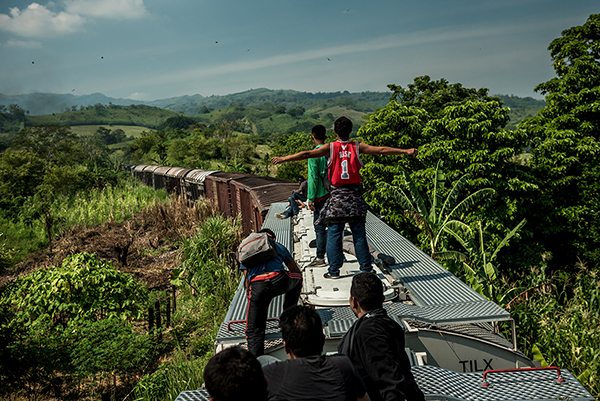 Meridith Kohut (born 1983, USA)
Meridith Kohut (born 1983, USA)
Climate Migration, El Salvador, Guatemala, Mexico, and USA, 2019-2020.
Photographs projected on three screens
Courtesy of the artist
Meridith Kohut is an award-winning photojournalist who has documented humanitarian issues and global health in Latin America for the foreign press since 2007. She spent five years documenting the economic crisis in Venezuela, resulting in dozens of front-page stories published in The New York Times. Her work in Venezuela is widely considered the largest and most comprehensive photographic archive of the crisis made by a single photographer. She has also chronicled the early months of the COVID-19 pandemic, climate-driven migration in Central America and the United States, labor rights and cholera outbreaks in Haiti, war widows entering the workforce in Syria, and gang violence and prison overcrowding in El Salvador. Her investigative work in Venezuela was a finalist for the Pulitzer Prize in Feature Photography in 2018. She earned a Courage in Journalism Award in 2018 from the International Women’s Media Foundation. Website | Instagram | Twitter
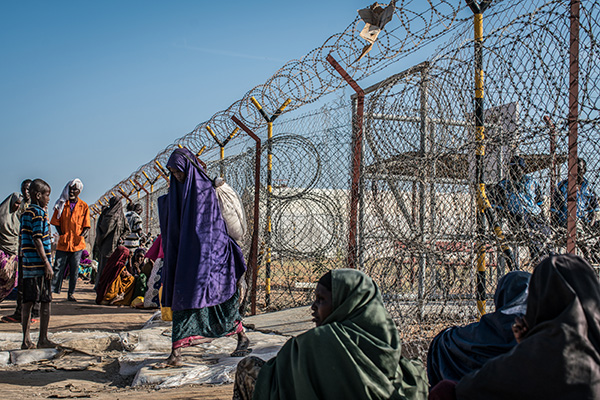
Nichole Sobecki (born 1986, USA)
From the series, Where Our Land Was, 2011-2017
Photographs projected on three screens
Courtesy of VII
Through documentary photography, Nichole Sobecki brings attention to humanity’s fraught, intimate, and ultimately unbreakable connection to the natural world. Born in New York, she has lived in Nairobi for the past decade. In 2016, Sobecki began her project “Where our Land Was,” which investigates the human consequences of significant environmental change in Somalia. She is currently exploring the vital role the Congo Basin plays in the ecological balance of our planet, as a National Geographic Explorer. Sobecki’s photography has been recognized by the Robert F. Kennedy Human Rights prize, the Leica Oskar Barnack Award, Pictures of the Year, the One World Media Awards, and the Alexandra Boulat Award for Photojournalism, among others. She is represented internationally by the photo agency VII, and is a member of Women Photograph and Everyday Africa. Website | Instagram
Hear From the Photographer
Nichole Sobecki at VII Agency
Somalia’s Land is Dying. The People Will Be Next, a photo essay for Foreign Policy
A Climate for Conflict, a talk given at the Nobel Peace Center
Human Consequences 2
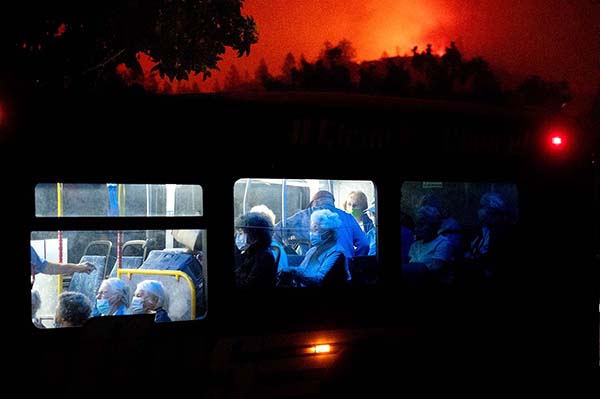
Noah Berger (born 1974, California, USA)
Wildfires in California, California, USA, 2020-2021
Photographs projected on three screens
Courtesy of the artist
Freelance photographer Noah Berger’s career spans 26 years, shooting for major news outlets including the Associated Press, San Francisco Chronicle, and Agence France-Presse. Berger specializes in documenting wildfires and social unrest. After covering the 2013 Rim Fire outside of Yosemite, he began devoting summers and autumns to documenting California’s fires. He often lives out of his car for days at a time in order to follow the fires as closely as possible. Along with colleagues at the Associated Press, Berger received the 2021 Pulitzer Prize in Breaking News Photography for his coverage of Black Lives Matter protests. He was a 2019 Pulitzer Prize Finalist in Breaking News Photography for his images of California’s deadliest fire season. Website | Instagram | Twitter
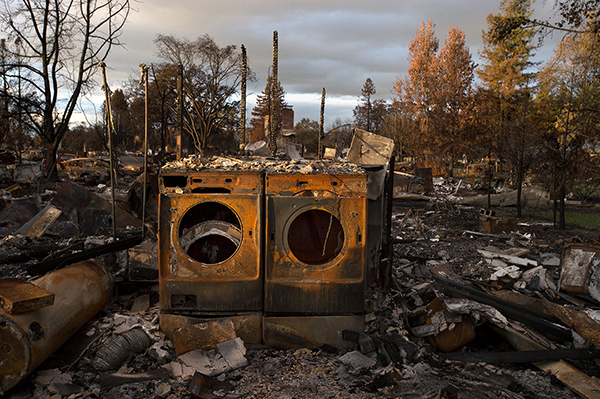 Darcy Padilla (born 1965, California, USA)
Darcy Padilla (born 1965, California, USA)
After the Wildfires, California, USA, 2009-2021
Photographs projected on three screens
Courtesy of the artist/Agence VU’
Darcy Padilla is a documentary photographer, an Associate Professor of art at the University of Wisconsin-Madison, and a member photographer of Agence VU’ in Paris. Her work focuses on long-term projects about struggle and its trans-generational effects. Padilla’s honors include a Guggenheim Fellowship, an Open Society Institute Individual Fellowship, an Alicia Patterson Foundation Fellowship, three World Press Photo Awards, and the W. Eugene Smith Grant in Humanistic Photography. Her photographs have been published in Granta, Stern, and The New Yorker, among other outlets. She was commissioned for a year to document the 2016 U.S. election for Le Monde. She has had solo exhibitions at Cortona On The Move (Italy), DOCfield Festival (Spain), and Visa pour l’image (France). Padilla’s book Family Love follows a family for 21 years, an intimate story of poverty, AIDS, and social issues. Website | Instagram
Hear from the Photographer
One morning I woke up, smelled the smoke, and stared out at the red-orange sky, then brushed away from the window sill the ash that had fallen. The Northern California firestorm had devastated the area and I walked out into the aftermath. I photographed the scarred landscapes and wandered the rubble and tried to make sense of the scattered pieces of people’s lives. These wildfires occurred where houses sit on the edge of nature. The housing crisis is pushing the boundaries of cities. In the United States almost 40% of homes are now at risk.
Darcy Padilla at Agence VU’ Darcy Padilla talks about her series ‘Family Love 1993-2014’, an interview with World Press Photo Foundation Climate Gentrification Could Exacerbate Housing Crisis in South Florida, a photo essay for Sierra MagazineFlooded Subways, Zhengzhou, China, 2021; New York and New Jersey, 2021
This found-footage collage by COAL + ICE co-curator Jeroen de Vries depicts flooded streetscapes and subway systems in Zhengzhou, China, and New York City. Most of the footage is taken from social media, captured by people who found themselves in the midst of the flooding and used their smartphones to document what was happening around them.
Jeroen de Vries is the designer and co-curator of Coal + Ice. He lives in Amsterdam and Belgrade and works as a freelance designer, curator and teacher. Website
3rd Floor Landing
Maya Lin (born 1959; Athens, OH, USA)
“The Map of Memory,” from What Is Missing?, 2024
Adapted from website What Is Missing?
Unchopping a Tree (2009), Blink (2014), Nature Based (2020), What If (2023), and Clear the Air (2024) from What Is Missing?
Single-channel compilation of five videos
Courtesy of the artist
Maya Lin is known for her large-scale environmental artworks, architectural works, and memorial designs, which explore how land is tied to history, memory, time and language.
What Is Missing? is Lin’s fifth and final project in her Memorial series. It focuses attention on species and places that have gone extinct or will most likely disappear within our lifetime if we do not act to protect them. The project exists formally as both permanent sculptures and as temporary media exhibits; but it also exists virtually—as a website, whatismissing.org, which acts as a nexus for the entire project.
The “Map of Memory” section of What Is Missing? highlights ecological histories of habitats, species, waterways, and cities—with timelines, videos, historic accounts, conservation success and disaster stories, and user-submitted personal memories. Interacting with the timeline on the touchscreen, you can explore a natural history of the earth—past, present, and future.
Please share your own memory of the natural world, helping to make a global memorial something personal and close to home.
Jake Barton (born 1972, Brooklyn, NY, USA)
The Accelerator 2050, 2024
AI-Chatbot, Carbon Vision Cards, Ice Flow Table
Courtesy of the artist
Since 2001, Jake Barton has been leading museum projects focused on leveraging history to inspire action, like the 9/11 Memorial Museum and the Tulsa Race Massacre Museum’s Greenwood Rising. Here he turns to the future.
The Accelerator 2050 is a time machine inviting visitors to see, talk, and inhabit a conditional future, one that is still in flux and undecided. By texting Future Me to 1 (877) 763-1612, you can talk with your “future self”, and hear about the impact of the climate actions you are going to take. CarbonVision Cards enable us to see carbon emissions with our own eyes, inspiring us as a “seeing-is-believing” species to make change now. Organized by categories from fashion to finance to local government to K-12 schools, the postcards list fundamental changes that are needed, and direct us to online playbooks and case studies called “We Made Change, So Can You.” Leveraging behavioral science, world-building, and storytelling, The Accelerator 2050 shows that change is real and invites us into the future to experience it.
Aron Gallery
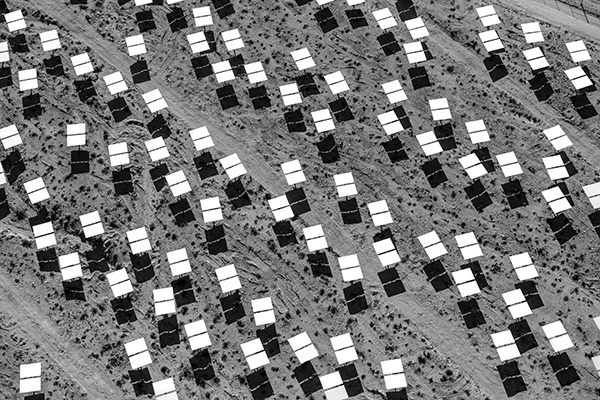 Jamey Stillings (born 1955, Springfield, MO, USA)
Jamey Stillings (born 1955, Springfield, MO, USA)
From the Changing Perspectives: Renewable Energy and the Shifting Human Landscape series
Courtesy of the artist
Concentrated Solar Power, California, USA, 2011–2014
Wind Energy, California, USA, 2013
Renewable Energy, Atacama Desert, Chile, 2017–2022
Photovoltaic Solar Energy, Japan, 2016
Photovoltaic Solar Energy, California, USA, 2013–2015
Concentrated Solar Power, Nevada, USA, 2014–2015
Wind Energy, Texas, USA, 2021
Concentrated Solar Power, California, USA, 2015
Since 2010, Jamey Stillings has been documenting renewable energy development through his aerial project, Changing Perspectives: Renewable Energy and the Shifting Human Landscape. The breadth of his work shows the global scale of the energy transformation currently underway, while also revealing the challenges and compromises of this rapid change. According to Stillings, his mission is, “to create imagery relevant to our present-day collective conversation and an eventual historical perspective of this era.”
Striking man-made designs and patterns set against the natural landscape spark curiosity and reflection. While some may think these solar panels and wind turbines are an intrusive addition to the natural environment, many of these projects make use of environments previously disrupted by extractive industries. When Stillings flew above Pompa Elvira, a solar thermal project at the Minera Gaby mine in Chile, he was taken with the shape the panels created, which resembles the female gender symbol. “Here’s a clearly man-made object that has a shine to it, that has an entirely different texture within the landscape of the copper mine….It really plays off the beauty and the potential of renewable energy against the very harshly used landscape.” Website | Instagram | Facebook
Hear From The Photographer
Jane Hirschfield (born 1953, New York, NY, USA)
Let Them Not Say, 2014
Courtesy of the artist
Called “American poetry’s central spokesperson for the biosphere,“ award-winning poet Jane Hirshfield wrote Let Them Not Say in 2014, but did not publish it until January 20, 2017. According to Hirshfield, “This poem was written well before today’s Presidential Inauguration and without this event in mind. But it seems a day worth remembering the fate of our shared planet and all its beings, human and beyond.”
Jane Hirschfield has published nine collections of poetry including The Beauty (2015); Come, Thief (2011); and Given Sugar, Given Salt (2001). She has won numerous awards and has been a visiting poet at Stanford University and the University of California, Berkeley. A graduate of Princeton University, she is also a trained zen practitioner.
Rockefeller Gallery
New York, 2050: A Possible Future, 2023
Video, sound, and scent installation with four-channel video
Courtesy of Ingka Group (IKEA)
This installation was originally created for Ingka Group’s Action Speaks Summit, September 18–24, 2023, New York.
Collaborators include:
Exhibition vision, concept, and experience design by Superflux
Project Management by Alexandra Deschamps-Sonsino
Architectural and graphic design by Isometric Studio
Fabrication by New Project Graphics production by DMR Graphics
Audio visual by ATD
Lighting by 4wall
Sound design by James Bulley Studio
Native Grasses by Interior Foliage Design
Scent by AromAtom
Scent diffusion by Scent Marketing Inc.


